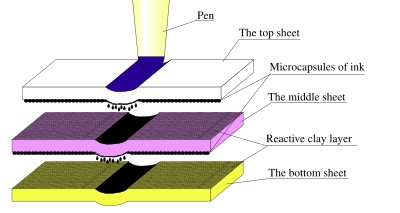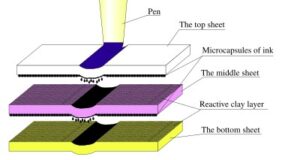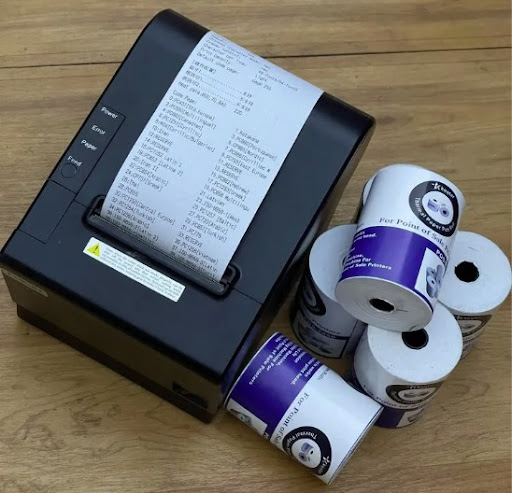Thermal paper, also called audit rolls, is a commonly used type of thermal receipt paper. It is specially designed for thermal printers, cash registers, and credit card terminals. Unlike regular bond paper, thermal paper is coated with dye and chemicals. So, the simple answer to the question, do thermal printers need ink, is YES.
This paper is sensitive to heat due to its chemical composition, which includes four main types of chemicals: leuco dyes, developers, sensitizers, and stabilizers. The advantage of this paper is that it doesn’t require costly ink or cartridges for printing, and the output usually has a brighter sheen than bond papers.

Image Source: ncco.com
Thermal printing, which was initially developed in the 1960s, became more prevalent with the arrival of the fax machine. Nowadays, thermal printing and the unique heat-sensitive paper it utilizes are commonly used.
The average consumer usually receives a receipt printed on thermal paper every day. Thermal printers are commonly used to print shipping box labels. Tickets for sporting events or concerts are often printed on thermal paper as custom printed receipt solution for various purposes.
Types of Receipt Paper
- Thermal Paper – To identify thermal rolls, you can scratch the surface with your fingernail and observe if black marks appear due to the heat generated while scratching. You can also feel the paper’s texture, which is usually smoother and shinier than other paper types. Alternatively, you could test the paper using a thermal printer, as carbonless rolls and wood-free papers will not work with this type of printer.
- Plain Bond – Bond paper is a thick and sturdy paper made with cotton rag fiber, unlike regular printer paper, made only with wood pulp. Plain bond is a type of printing paper used in dot matrix printers, but it tends to fade quickly and can smudge in hot or moist conditions.
- Wood-Free Paper – Using the term “wood-free” for paper is confusing because the paper is made from trees. However, “wood-free” means that the paper has gone through a chemical process to remove lignin, a substance found in trees that causes the paper to become yellow and old-looking over time. Lignin makes trees strong and tough, but it negatively affects paper. So, while “wood-free” paper is not free from trees, it is free from lignin, which prevents it from deteriorating quickly.
- Carbonless Paper – The purpose of carbonless copy paper or No Carbon Required (NCR) is to eliminate the use of a carbon paper layer between sheets when making document copies. In the past, carbon paper was necessary for creating multiple receipt copies. The user would manually insert a sheet of carbon paper between two regular sheets of paper – known as “carbon interleaving.” Despite its effectiveness, this process presented several challenges. With carbonless paper, created by chemists Lowell Schleicher and Barry Green, it is possible to produce multiple copies with minimal pressure.


Image Source: wikipedia.org
Comparing Different Types of Receipt Paper
Thermal paper, wood-free paper, and carbonless paper are available in white color. Carbonless paper is also available in pink or yellow colors like thermal POS paper. The thermal and carbonless paper has a coating, while the wood-free paper is free from any coating.
Also read: Essential Tips for Finding Quality Thermal Paper
Advantages of Using Thermal Receipt Paper
- Low Printing Cost – Thermal paper rolls are a more affordable printing option than other paper and printing methods. Using regular paper can be expensive not only because of the paper cost but also because of ink expenses. Buying ink or toner can cost more than the printer itself over time. On the other hand, the thermal paper does not require ink, cartridges, or toner, as it uses heat instead to create images. This makes it a cost-effective option for businesses and industries to save considerable money.
- Minimal Maintenance Cost – Thermal papers has the significant benefit of low maintenance as it does not require expensive ink or toner replacement, which reduces costs substantially. Only a periodic cleaning of the printer head is needed. Moreover, repairs are rarely necessary due to the printer’s simple design with few moving parts, making it less likely to jam than other printers. Hence, the maintenance cost is considerably lowered.
- Better Speed – Conventional printers use ribbons to transfer ink to paper, which makes them slow. In contrast, thermal printers use thermal printing heads to produce images almost instantly, allowing for more lines per second and images that dry instantly. This faster printing speed helps customers get their receipts quickly, reducing wait times.

Image Source: indiamart.com
- High-Quality Paper – Thermal paper is coated with a smooth surface that reacts chemically when passed through a heated printer head, creating a high-definition image without ink. This eliminates concerns about smears and smudges that could make the image or words difficult to read.
Why Should You Consider Using Thermal Receipt Paper?
If you look into differences of thermal paper vs regular paper to consider investing in, the thermal receipt paper is to be considered because it differs from regular printing papers and has additional features. These include image stability, static density, dynamic sensitivity, and density. While the regular paper has properties like thickness, moisture, and grammage, bpa free thermal paper is specially designed for receipts. You can test thermal custom paper rolls and compare them to regular paper to better understand the differences.
Conclusion
In conclusion, thermal receipt paper has many advantages, enabling businesses to provide customers with a more secure and reliable receipt experience. In the long run, it also helps in saving time and money. This makes it an excellent choice for most businesses seeking improved customer satisfaction and cost efficiency.
Moreover, the thermal paper roll size durability and environmental friendliness are a bonus. So thermal paper is the answer if you’re looking for superior quality, flexibility, and convenience in handling your receipts. So reach out to Telemark Diversified Graphics for your thermal paper needs today and enjoy all the benefits of using this effective technology.
FAQs
What is thermal paper?
Thermal paper, also known as audit rolls, is a type of paper used for receipts. It is designed for use specifically with thermal printers, cash registers, and credit card terminals. Unlike regular bond paper, thermal paper has a chemical coating that includes dye and chemicals, making it heat-sensitive.
Mention the benefits of using thermal paper.
If you’re not using thermal paper, your business may miss out on many benefits. Thermal paper is known for its durability, excellent printing quality, time-saving properties, low maintenance costs, and reduced printing costs. On the other hand, using regular printing paper could provide your customers with low-quality receipts and spend more on printing.
What are the different types of receipt paper?
Receipt paper comes in various forms, each ideal for different purposes like custom receipt paper. Plain bond custom print paper rolls is a common choice. However, it can fade and smudge easily when exposed to moisture or heat. Thus, if you are thinking how are receipts printed, you should know that thermal receipts use specially coated surfaces and rely on special printers using heat to reproduce an image onto the page. Carbonless copies offer multiple-layer chemical coatings, which allow them to make prints without traditional ink or carbon powdering agents. In addition, wood-free papers have been processed chemically, so lignin from trees does not cause them to be yellow over time – making this type more durable for thermoprinting on wood-free paper than plain bond paper.


